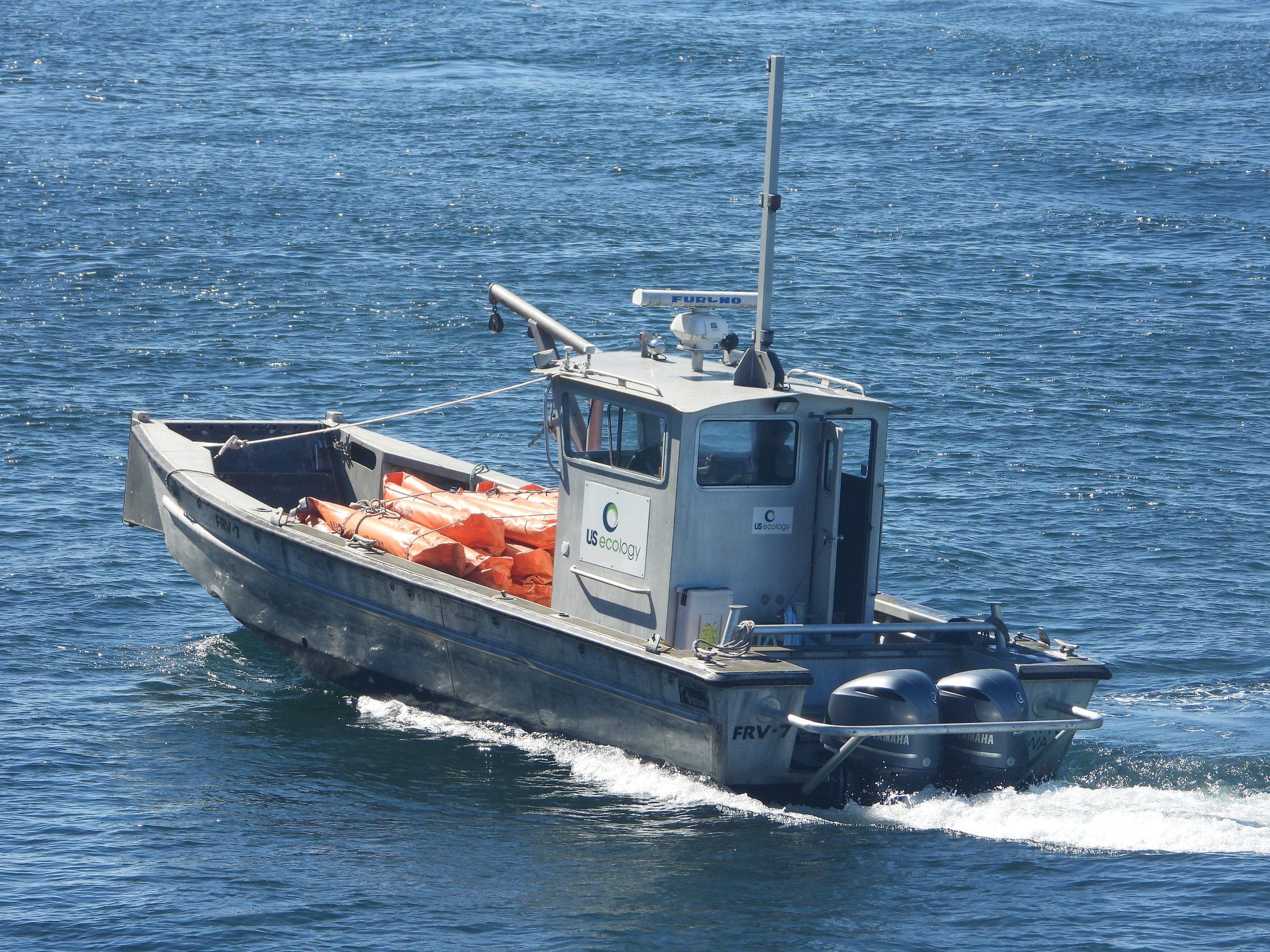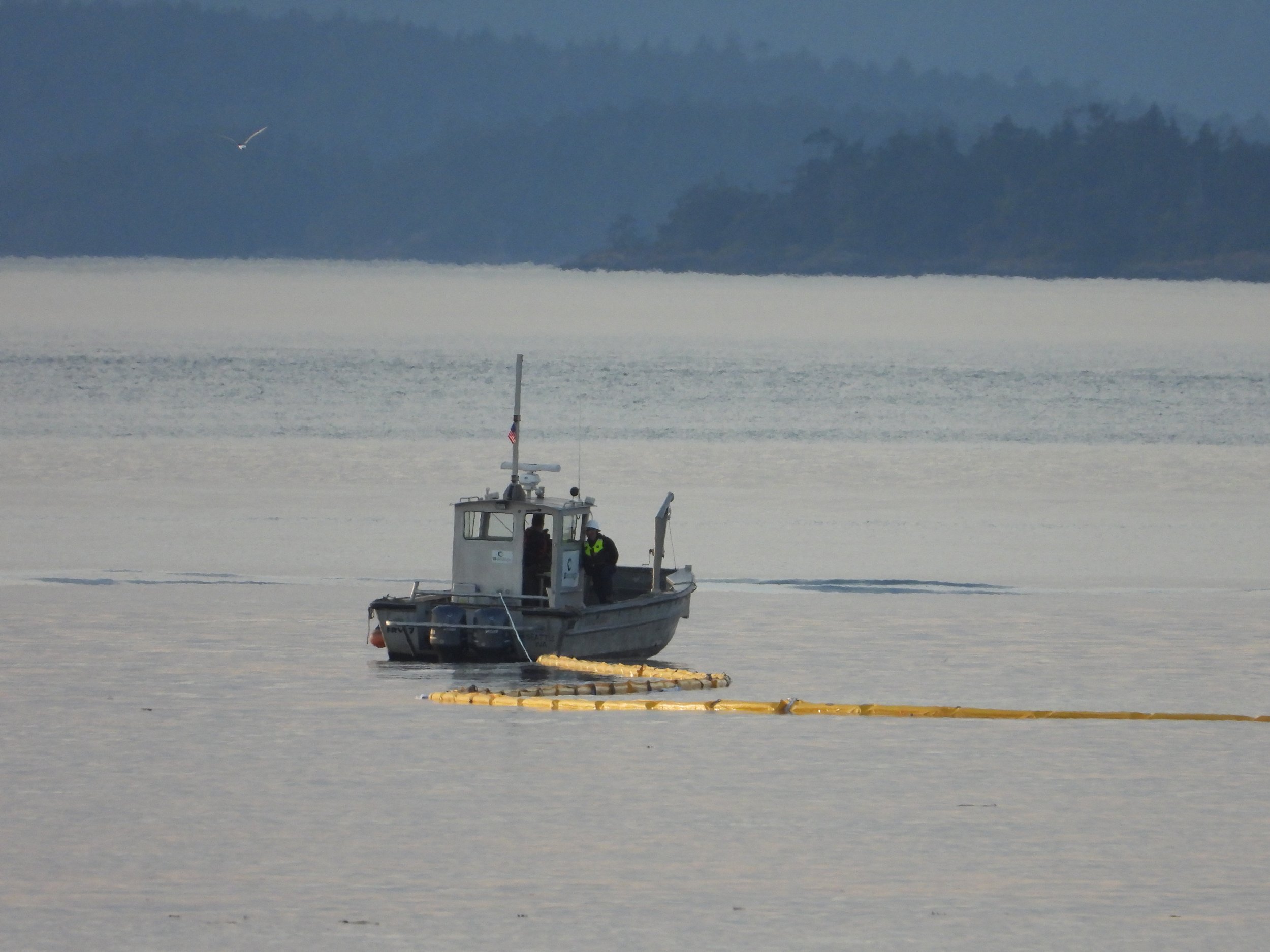Aleutian Isle Shipwreck & Diesel Spill in Critical Habitat
Current Update:
As of Wednesday, September 21, 2022, 8:00PM PST:
After relocating the barge and crane carrying the Aleutian Isle to Mitchell Bay, crews were able to safely re-rig the vessel, allowing them to complete the dewatering process without breaking or dropping the vessel. After the vessel was successfully dewatered, it was placed on a recovery barge where it will be secured for transport.
Boom was placed around the entire work area, and during the process of moving the vessel, light sheening was present as anticipated. Some sheen and pollutants escaped past the boom perimeter, but it was too light to be recovered. During operations whale deterrence teams remained on standby but were not needed as no whales were present in the area.
Over the next few days, crews will work to remove additional petroleum products and other hazardous materials from the vessel and secure the vessel to be safely transported to a shipyard in Anacortes where it will be under the custody of the United States Coast Guard for survey and to begin the investigation process.
The sinking of the fishing vessel Aleutian Isle in critical habitat for endangered Southern Resident killer whales prompted an emergency spill response.
What Happened:
Around 2pm PST on Saturday, August 13, 2022, a 49-foot fishing vessel called the Aleutian Isle sank off the west side of San Juan Island near Sunset Point, causing a small-sized diesel fuel spill into critical habitat for the endangered Southern Resident killer whales.
The five crew members onboard were safely rescued by two other fishing boats in the vicinity, the Marathon and the Intruder.
The Aleutian Isle had a diesel fuel tank capacity of 4,000 gallons but was said to only have had an estimated 2,500 gallons of diesel in the tank in addition to an estimated 100 gallons of motor oil and other oils. During the initial wreck, the vessel leaked an unknown amount of fuel into the water causing a visible sheen and odor that was observed Saturday and Sunday throughout the day, and periodically throughout the week. The National Oceanic and Atmospheric Administration (NOAA) categorizes this pollution event as a small size diesel spill (500 -5,00 gallons).
The United States Coast Guard (USCG) was notified of the incident and deployed response units (MH-65 Dolphin helicopter, 45-foot Response Boat, and 87-foot Coast Guard Cutter Swordfish WPB-87358) to aid in the incident. The USCG Swordfish remained on the scene overnight and throughout the following days to monitor the pollution event.
Southern Resident Killer Whales in Proximity
Earlier on the same day of the wreck (August 13th), reports came in of all three Southern Resident killer whale pods (J, K, and L) traveling east in the Strait of Juan de Fuca towards San Juan Island. What started off as excitement about the potential to see a Super Pod quickly turned into fear and concern as the news of the sunken vessel and diesel spill became known.
It wasn’t until the early evening that Southern Residents were sighted off the west side of San Juan Island, ranging between Eagle Cove and the Westside Preserve, also known as Landbank, about 4 miles south of the spill site. Multiple individuals and agencies, including Orca Conservancy, observed and listened from shore throughout the evening to monitor the whereabouts of the whales. Members from Orca Sound, The Whale Museum, and Orca Network monitored hydrophones throughout the night.
No whales were seen or heard on the west side throughout the night and were presumed to have gone southwest and offshore of the island throughout the night. By early Sunday morning, reports from passengers aboard a ferry out of Port Angeles saw a large pod of orcas, presumably the Southern Residents traveling west. This was confirmed by members from the Center for Whale Research who reported seeing Southern Residents between Port Angeles, WA and Victoria, BC, Canada. Agencies and volunteers continued to monitor various locations and hydrophones along the west side in the event that any orcas or other whales returned or entered the spill zone.
Understanding Diesel Spills:
Diesel is a light, refined petroleum product that has a low viscosity and is lighter than water, causing it to sit on the surface and easily disperse or evaporate. Since diesel is more lightweight than water, it sits on the surface forming a rainbow sheen, and it is not possible to sink and accumulate on the seafloor or pool as free oil. Unlike black oils such as crude oil, diesel is not sticky or viscous, which means it won’t stick to or coat animals or sink and accumulate (with the exception of bird feathers). In most cases, recovery efforts are minimal since 90% of diesel in a small spill incident will evaporate or disperse within a matter of few hours to a few days.
An expert closely monitoring the spill stated, “A sunny day will do much more than any cleanup efforts.” The spill occurring in the peak of the summer with warm to hot forecasts was favorable for this pollution event. The warm and sunny days helped to naturally evaporate the spilled diesel. Small spills seldom require large spill cleanup efforts, but in the case of the Aleutian Isle, precautions were put in place to protect habitats and sensitive marine life.
In terms of toxicity, diesel is considered to be the most acutely toxic oil types. Animals and organisms such as fish, invertebrates, or seaweed that come into direct contact can be killed. However, spills occurring in open water cause pollutants to disperse rapidly diluting the diesel, as is the case in the Aleutian spill. Diesel poses a larger threat to animals in confined and shallow waters.
Invertebrate animals such as crabs and shellfish can be tainted by diesel when exposed in shallow waters near shore. Invertebrates can bioaccumulate diesel, but it will depurate contaminants over time, typically a few weeks after exposure.
One of the biggest concerns to wildlife in the event of a diesel spill is marine birds. Since diesel sits atop the water surface, sea birds risk coming into direct contact with contaminants. Typically the amount of birds affected is low since diesel disperses quickly, however, mortality can be caused by ingesting diesel from preening feathers, or matted feathers causing hypothermia. Birds face the biggest threat in the event that a spill occurs next to a nesting colony, or sheen is transported to areas with large bird concentrations. In the event of the Aleutian Isle spill, booms were placed around critical habitats to attempt in protecting wildlife including birds.
Logistical Challenges:
While diesel is the lesser of the threats compared to other contaminants such as crude oil, this incident did pose a variety of logistical issues. On the original date of the incident, the Aleutian Isle was reported at a depth of 100ft. At the time, the best course of action was deemed to salvage the wreckage to contain the spill. With the geographic nature of the incident location, which has strong currents and deep depths, the wreckage shifted to depths greater than 200ft, posing even more logistical challenges and safety concerns for respondents. Response units had to source additional equipment and tools in order to salvage the wreckage, and the task is still ongoing as conditions change.
Geography: The location of the wreck is in Haro Strait, a passage between Vancouver and Saturna islands in British Columbia, Canada, and San Juan and Stuart islands in the United States. the US and Canadian border passes along the center of the strait, which extends north through the Strait of Georgia to the southwest of the Strait of Juan de Fuca which connects to the Pacific Ocean. The depths throughout Haro Strait range considerably, averaging 600-900ft mid-channel, and the greatest depth being recorded at 1,356ft, a depth greater than that of the Eifel Tower.
Depth: Deep depths pose major safety concerns for divers. To put it into a perspective, recreation diving has a maximum limit of 40ft. A dive deeper than 60ft is considered deep diving and requires specialized training, oxygenized gas mixtures, and the use of a decompression chamber to ensure the physical safety of the divers. Without these protocols, divers could risk health issues including but not limited to Decompression sickness “bends”, Nitrogen narcosis, arterial air embolism, and more. Specialized gas mixes as well as equipment to allow divers to reach the depth of the wreckage had to be transported to the location.
Tides/Currents: The width of Haro Strait is a minimum of 6 miles. Because of its width and connection to the Strait of Juan de Fuca connecting to the ocean, combined with the great depth, this strait produces strong and powerful currents. These powerful currents have caused the wreckage to shift from a depth near 100ft to a depth greater than 200ft, causing additional challenges to salvage the wreckage and contain the spill.
Location: The wreckage occurring off the west side of San Juan Island, posed accessibility issues as it requires a minimum of an hour-long ferry ride. Washington residents familiar with the San Juan Islands likely have experienced the challenge of reserving a ferry or housing during peak tourism season in the summer. This proved to be a challenge for agencies, officers, and volunteers attempting to get on the island to assist in the spill response. The USCG officers that spoke with members from Orca Conservancy stated that they had intended to arrive the previous day to conduct air assessments but were unable to find available housing. Other experts critical of the response efforts posed questions as to why was additional equipment not staged closer and made more accessible to San Juan Island, especially with the island’s location on a major shipping route and designated critical habitat for endangered Southern Residents. The distance of the island tacked on additional days to the response with the need to transport supplies and equipment needed in the response.
Deterrent Vessels and Hazing Drills:
Haro Strait is at times a super highway for a variety of species of whales. With the Strait of Juan de Fuca connecting to the ocean, species like Resident and transient killer whales, humpback whales, minke whales, and the occasional gray whale traffic in this area frequently, especially during the summer months. With the critically endangered Southern Resident killer whales a few miles south the day of the spill, and the strait being a heavily trafficked route for whales, protocols were put in place to deter cetaceans from spill locations.
Unified Command worked with local agencies and research organizations such as Soundwatch and Wild Orca, who operate research and enforcement vessels, and was able to assist in deterrent programs.
Deterrent and hazing protocols were deemed necessary as past studies on captive cetaceans and major spill incidents including the Exxon Valdez oil spill in Alaska in 1989 and a diesel spill in Robson Bight, BC, Canada in 2007 have determined that cetaceans lack a sense of “smell” or ability to detect pollutant hazards and will blindly swim into oil slicks.
The method chosen to use in deterrent and hazing operations is a practice called Oikomi pipes, which is the use of metal pipes placed in water when struck with a blunt object creates a loud and disruptive noise that detours whales and other cetaceans. While banging a metal pipe underwater may not seem like much, this method has proved successful, unfortunately, in wild cetacean capture efforts including the Taiji dolphin hunts. It has also been used successfully to herd and free killer whales trapped in a freshwater lake in Alaska. Cetaceans such as dolphins and killer whales are especially sensitive to noise since they are acoustic animals that use sound to communicate with one another and use echolocation to hunt and find food. This is a much more preferred method to the alternative of helicopter hazing, sonar, or dynamite which could have more severe impacts on wildlife.
The weeks following the initial incident, local entities such as Soundwatch, Wild Orca, as well as the Canadian Marine Mammal Unit conducted hazing drills to prepare in the event that sensitive wildlife return to areas in which they risk becoming exposed to pollutants.
Potential Impacts and Risks to the Southern Resident Killer Whales:
One of the major threats to the Southern Residents is toxic pollution, so any chemical spill poses a risk to the health and safety of a sensitive population. However, unlike other heavier oils or chemicals like crude oil, diesel poses a slightly smaller risk.
The major concern of the Southern Residents entering a spill location is the potential inhalation of toxic fumes that sit on the water surface. Since the orcas come to the surface to breathe, they risk inhaling vapors on the surface which can then enter their lungs and have the potential to cause lesions, pneumonia, or systemic toxicity. There is also the concern of the diesel fuel entering the food chain from the biofilm on the surface which can be ingested by phytoplankton and zooplankton, which are consumed by other species and can work its way up the food chain.
There is some concern regarding the impact of the spill on wild salmon, which includes sockeye and Chinook salmon migrating to spawn at the Fraser river, however, the fish should remain safe from the pollutants on the water surface since they spend most of their time in deeper water, limiting their exposure to pollutants.
A similar incident posed a risk to the Northern Resident killer whales in 2007 when a barge transporting logging equipment which included a fuel truck carrying over 260 gallons of diesel and numerous other vehicles spilled into critical orca habitat. Based on hydrophone audio recordings picking up loud intense sounds immediately after the incident, it is believed that fuel tanks imploded on impact, and was shortly followed by a slick reaching up to almost 5 miles.
Later that evening, the A30 clan was seen traveling slowly through the thickest part of the contamination, and then back east through the spill later again, totaling 6 hours of exposure to concentrated diesel fumes. Shortly after the A30s passed through the contaminants, the A4s, A5s, I15s, and I33s were also observed swimming through the contaminants, exposing more than 50 Northern Resident killer whales to diesel fumes. Since this incident, no mortalities or health issues were reported.
It is worth noting that the Northern Resident killer whale population is substantially healthier than the critically endangered Southern Residents. And while the Northern Residents seemed unharmed in the 2007 diesel spill, this does not guarantee the health and wellness of a population that is under a lot of physical stress and malnutrition. A diesel spill may not be a death sentence, but it could risk placing additional stressors on an already struggling population.
The Takeaway:
This pollution event, in some degree, has turned out to be a best-case scenario given the circumstances, but leaves us with the looming question of what about the next time, and serves as a reminder about the real threat of a pollution event as well as the impending dangers that projects such as the Trans Mountain Pipeline pose on a fragile ecosystem. Haro Strait is a major shipping channel for both the United States and Canada and is bustling with a large volume of tanker traffic, including oil tankers transporting crude oil overseas.
Speaking truthfully, we got lucky this go around. The combination of the spill being diesel as opposed to crude oil, the warm sunny weather to quickly evaporate contaminants, calm conditions to allow for surveys and booms, and the Southern Residents leaving the area, have immensely aided in the response efforts. But this is just one event. If the Trans Mountain Pipeline continues to move forward, it will increase traffic transporting crude oil sevenfold, for a total of 408 trips a year, increasing the chances of a catastrophic spill comparable to the Exxon Valdez oil spill which lead to the mortality event of Resident and transient killer whales condemning the unique pods and their cultures to extinction.
The Aleutian Isle is a very real reminder of the looming threat that faces the critically endangered Southern Resident killer whales.
Timeline of Events:
Saturday, August 13, 2022
10:30AM: All three Southern Resident killer whale pods are spotted by a fisherman at Sheringham Lighthouse in Shirley, BC, Canada, on Vancouver Island.
2PM: the Aleutian Isle sinks, leaking unknown amounts of diesel into Haro Strait.
3PM: USCG Cutter Swordfish arrives on scene, pollution survey and initial response efforts with partner agencies is initiated.
4PM: Reports of Southern Resident killer whales spread out east of Race Rocks (located in the Strait of Juan de Fuca).
5PM: Department of Ecology is notified of the sinking vessel. Sheening is visible and reported covering 1.75 miles by USCG.
7:17PM: Southern Resident killer whales are visible from San Juan Island and are seen spread out between Eagle Point and south of Landbank, an estimated 4 miles away from the diesel spill site.
7:45PM: Leaders of the Southern Resident killer whales, including J19 Schachi are visible from Landbank, slowly trending north. J19 is visible from the naked eye a quarter of a mile offshore on the south end of Landbank, and then turns around back South (away from the direction of the spill).
9PM: Last visible reports of Southern Resident killer whales come through.
10PM and on: multiple individuals and organizations monitor hydrophones throughout the night to track location of Southern Residents. No Southern Residents were detected on the Lime Kiln hydrophone (estimated 2 miles south of the spill), nor on the Orcasound hydrophone to the north of the spill. Orca Conservancy members camping at the County Park campground just a mile south of the incident, listened and scanned the water periodically throughout the night and did not see any whales (note the waxing gibbous moon illuminated the waters throughout providing good visibility despite the lack of daylight).
Sunday, August 14, 2022
6AM: USCG officers arrive at County Park on San Juan Island and begin conducting drone surveys to assess the slick. The Orca Conservancy members at County Park briefly spoke with the officers and notified them of the presence of the Southern Resident killer whales south of the spill site the previous evening. USCG provided the Joint Harbor of Operations (JHOC) phone number and requested that any whale sightings be reported so deterrent boats could be deployed as needed. This number was shared with local sightings groups and agencies to monitor for wildlife. Sheening is at the County Park beaches, as well as a strong smell of diesel.
7AM: Reports of Southern Residents traveling west (towards ocean away from San Juan Island and spill) between Port Angeles, WA and Victoria, BC, Canada.
9AM: Unified Command for the spill response is established and comprised the USCG, Washington Department of Ecology, San Juan County Office of Emergency Management, and the Swinomish Tribe, with support agencies including NOAA, Washington Department of Fish and Wildlife (WDFW), Island Oil Spill Association (IOSA), National Marines Fisheries Service, and the US Fish and Wildlife Service.
9AM - 11AM: USCG conducts air surveys over the spill and wreckage location
11AM and on: US Coast Guard, Canadian Coast Guard Environmental Response, WDFW, Orca Network, Soundwatch, and NOAA arrive on the scene to monitor the location of whales in the vicinity. Orca Conservancy members remain at County Park along with other non-profit organizations (including members from Dam Sense, and a former volunteer with IOSA) to monitor for wildlife on shore. Observers on shore saw derelict fishing gear (a large fishing net) free floating from the wreckage, remaining in front of County Park south of Low Island for the duration of the day.
2:30PM: Abrosrbant boom is placed near certain shorelines to protect wildlife from slick. WDFW opens an oiled wildlife hotline to report any oiled wildlife in the vicinity.
7PM: Response contractors are on scene to plan the next steps to remove the fuel remaining on the submerged vessel.
Monday, August 15, 2022:
A safety zone was placed around the response area, vessels are required to remain a minimum of 1,000 yards from any vessel conducting dive operations.
Air quality operations conducted by the Department of Ecology are underway. Ecology reported that air quality levels remained below harmful thresholds.
2,1000 feet of absorbent boom had been placed in areas including Small Pox Bay and Open Water Bay to capture surface oil.
Dive operations began but the divers were not able to locate the vessel due to shifting in tidal currents. The vessel was again located around 200ft in depts.
Recovery crews marked the location of the derelict fishing net and set a plan to extract it the following day.
Unified Command continued to work with multiple departments and agencies to monitor for marine life.
Tuesday, August 16, 2022:
USCG continues to conduct drone and helicopter overflights to assess the spill, morning overflights show a reduction of sheening on the water, indicating that much of the spill had been evaporated in the sunny weather.
A specialized Remote Operated Vehicle (ROV) supplied from the USCG is brought to San Juan Island to conduct additional analysis on the submerged wreckage.
The USCG Cutter Henry Blake arrives on scene to assist in the recovery of the loose seine net on the surface. Divers begin operations to remove a second net submerged near the original location at 100ft. Divers were able to successfully remove several panels of netting.
There was a visible reduction in sheen on the water. Air and water quality surveys continued. By mid-afternoon, the sheen appeared to have completely dissipated while air monitoring showed that air levels remained normal.
More than 3,000ft of absorbent boom was placed as a precautionary measure.
Local fisheries opened to salmon fishing, fishermen were advised not to fish in areas where sheen was present.
No wildlife (marine, terrestrial, or airborne) appear to be impacted by the pollution.
Wednesday, August 17, 2022:
The ROV determined that the vessel remains upright at a depth below 200ft, the hull and the fuel tanks also remained intact.
Visible sheen was observed from overflight operations and confirmed by surface crews, indicating that despite the fuel tank remaining intact, small amounts of diesel are venting from the tank.
Hazing drills are underway with USCG, Soundwatch and Wild Orca practicing the use of Oikomi pipes and training personnel on response tactics.
USCG Cutter Henry Blake recovered additional netting, weighing 400lbs, lifted by a crane, from the vessel. The netting had a total of 5 dogfish entangled, one was successfully released. No other wildlife was found entangled. The removal of the netting will allow additional salvage operations to continue as the netting posed a hazard to wildlife and divers.
3,800ft of booming remains in place.
Thursday, August 18, 2022:
Additional specialized equipment and gear to allow divers to dive to the necessary depths are being retrieved for salvage operations to commence.
Due to the strong currents of Haro Strait, operations must wait until the apex of high or low tide, known as the slack tide, to allow divers to safely access the site.
Slight sheening remains, booming remains in place as a precautionary measure.
No reports of oiled wildlife have come through, and no reports of Southern Residents returning have come through.
Friday, August 19, 2022:
Unified Command met with the San Juan County council to discuss the event and the response. The event was life streamed and can be viewed here.
Dive operations remain on hold pending the specialized equipment including gas mixtures and decompression chambers for divers, and a barge and crane to lift the wreckage.
Qualified personnel continues to monitor the wreckage and location of protected marine species. Acoustic deterrents are staged for use as needed.
Sunday, August 21, 2022:
An additional 1,500ft of absorbent boom has been placed around White Point Peninsula out of precaution to protect environmentally sensitive areas in case pollutants move closer to shore. The total amount of boom laid is 2,300ft.
Dive operations continue to remain on pause while required specialized equipment is transported to the area.
Cross-border training with the Canadian Marine Mammal Unit is scheduled for Thursday. This team will assist in wildlife deterrent as needed, as well as overflights of the spill.
Air and water assessments show the amount of sheening remains minimal. The sheening that is visible is originating from periodic venting of the submerged diesel tank.
Monday, August 22, 2022:
A barge and crane begin the route to San Juan Island from Seattle.
Specialized gas mixtures to allow divers to dive into the required depths are being produced.
Overflights and shore assessments continue. Sheening remains minimal.
Absorbent boom is added and remains in place to protect environmentally sensitive areas from pollutants.
Wednesday, August 24, 2022:
Response teams conducting Shoreline Cleanup Assessment Techniques (SCAT) to locate impacts of the sunken vessel from shore. No oil or sheening is visible from shore.
Overflights conducted by helicopters and drone confirmed no sheening was visible.
No wildlife has been observed in the response area, including Southern Resident killer whales.
Thursday, August 25, 2022:
SCAT teams continue to patrol environmentally sensitive areas to monitor for pollutants.
USCG unnamed aircraft system (UAS) operators continue to conduct aerial patrols and assessments. No sheen was observed, but crews continue to monitor and remain on standby to adjust booms or materials as needed.
Cross-border training for wildlife deterrent and hazing with the Canadian Marine Mammal Unit commences.
Friday, August 26, 2022:
A barge carrying a crane pushed by tug Captain Cae arrived in Snug Harbor, San Juan Island.
The wind and sea conditions posed hazards and safety concerns to salvage efforts for dive operations and were placed on hold for safer conditions and a slack tide.
Salvage efforts will commence over the weekend pending safe weather and sea conditions.
There is still concern that the vessel will shift to deeper depths, if the vessel continues to shift to deeper depths, salvage operations may not be possible.
Sunday, August 28, 2022:
The barge and crane that will be used to raise the Aleutian Isle has been securely anchored and are prepared for salvage operations.
A mixture of heliox (oxygen and helium) to allow divers to reach depths greater than 200ft has arrived on San Juan Island and is being prepared for use. Note, the last recorded location of the sunken Aleutian Isle was at a depth greater than 200ft.
Dive operations can only be safely conducted during optimal conditions which include slack tide, water currents, above-ground weather, and other factors.
Additional precautions also need to be taken to ensure the safety of the divers and a successful recovery, including removal of hazardous debris at the dive site, verification of the vessel’s structural integrity, securing the vessel’s fuel tank to prevent additional pollution. It is estimated that once dive operations commence, it will take ten days.
The Federal Aviation Administration (FAA) has issued a Temporary Flight Restriction (TFR) around the incident site to prevent distraction and disturbance to crews in the response. The public is not to fly drones within 800ft above areas around Henry Island and Garrison Bay down to Eagle Point. Information on the TFR can be found on the FAA website here.
Inconsistent sheening is sometimes observed. This sheening is unrecoverable. Unmanned Aircraft Systems (UAS) and Shoreline Cleanup and Assessment Technique (SCAT) teams continue to monitor sheening and impact of pollutants around the incident site.
Locations of Southern Resident killer whales (SRKWs) have been continually monitored, no SRWKs have been located near the site. Personnel continue to train and are staged to act as deterrents as needed.
Wednesday, August 31, 2022:
A Remote Operated Vehicle (ROV) was deployed and confirmed that the Aleutian Isle fishing vessel is lying hard on the starboard side with the hull facing up a slope. The vessel has not moved and still remains at a depth greater than 200ft.
Divers are preparing for the next window of opportunity to begin salvage operations.
Air monitoring continues with no elevated levels of concern in addition to no visible sheening observed on the water.
Southern Resident killer whales (SRKWs) have not beeb detected near the wreck site. Deterrence teams are on standby in the event that SRKWs are detected within the area.
The Temporary Flight Restriction (TFR) has been extended until October 15th, 2022.
Friday, September 2, 2022:
Yesterday (9/1) at 10:45AM Southern Resident killer whales (SRKWs) were reported coming in from Race Rocks off of Vancouver Island, British Columbia, Canada. A heavy fog came through Haro Strait in the afternoon causing visibility issues. Exhalations were audible from shore along the west side of San Juan Island during the heavy fog and SRKW calls were picked up on the hydrophone confirming the presence of J Pod. Unified Command had been informed of the whereabouts of SRKWs. Straitwatch was on scene reporting SRKW locations to the USCG. Due to the lack of active sheening deterrence and hazing protocols were not conducted.
On Wednesday 8/31 diver operations commenced aided by a Remote Operated Vehicle (ROV). Divers began cutting away netting to prevent entanglement hazards for both divers and rigging operations. Divers were also able to locate four valves (including valves for waste oil, hydraulic fluid, and water) and secure them shut.
On 9/1 divers began working to secure the fuel oil vents as well as continue to remove entanglement hazards.
Thursday, September 8, 2022:
Operations have been underway throughout the week to prepare the vessel to be lifted to the surface. This process will take several days due to strong currents and environmental conditions.
A safety zone remains around the site and boaters are being asked to stay out of the area to allow responders as much space as possible. Boaters that violate the Safety Zone can receive the maximum civil penalty of over $94,000 a day.
J Pod has remained in the area on and off, traveling up and down the west side of San Juan Island, had has passed the wreck site a few times. Deterrent boats were not initiated due to no active sheening while the orcas were present. Transient orcas including the T60s have also passed through the area, directly over the wreckage site.
September 7th, light sheening was detected but is too small to recover and will dissipate quickly. There has been no impact on whales or other wildlife.
Additional booms have been placed along bays and shorelines including Deadman Bay and Roche Harbor in preparation to protect shallow habitats while the vessel is being raised, which could potentially leak pollutants into the water.
Agencies continue to do air monitoring with no elevated levels of concern. United States Coast Guard, Department of Ecology, Swinomish Fisheries Patrol, and other agencies have remained on scene to monitor the site, wildlife, and pollutants.
Saturday, September 17, 2022:
Over the past week responding units and dive teams were able to successfully rig the rest of the sunken Aleutian Isle and are preparing to raise it out of the water pending optimal currents and weather conditions.
Operations to raise the sunken Aleutian Isle commenced and the vessel was successfully raised to the surface. Upon reaching the surface, the vessel was leaning on the starboard side. Dewatering of the vessel commenced, but the vessel remained too heavy to be placed on the recovery barge and had to be left suspended and partially out of the water.
During the process of lifting the Aleutian Isle, visible sheening was present as expected. Multiple agencies including the USCG, Washington Department of Ecology, US Ecology, and more were on scene with multiple vessels and boom to recover pollutants
Unified Command executed a pollution mitigation strategy to minimize pollutant leaks. All known valves and fuel vents have been plugged, but there are pockets of fuel trapped in the vessel. Responders anticipate fuel will be dislodged during the lifting process, but do not expect it to be an amount that would cause environmental risk. Preparations have been made for worst-case scenarios.
In preparation for that vessel to be raised, 7,300 ft of boom has been placed around sensitive marine habitat, and additional boom is on hand and ready to be deployed as needed. Skimmers are at the ready to be deployed to collect recoverable pollutants.
Water and air quality monitoring continue. Aerial surveys will be conducted to monitor sheening. Whale deterrent teams are staged and ready to be deployed if needed, and wildlife monitoring teams will be on the water to track wildlife and deter birds from active sheening areas.
Sunday, September 18, 2022:
Reports came through of SRKWs traveling east in the Strait of Juan de Fuca towards San Juan Island. From the location they were sighted, it was estimated to be 6 hours until they could potentially arrive along the west side of San Juan Island.
Whale deterrent boats remained staged and ready to be deployed. If SRKWs were to enter the wreckage zone they would be hazed in order to protect them from any potential contaminants that may be in the water from the lifting process.
USCG and US Ecology have been conducting air surveys throughout the day to monitor pollutants. No active sheening was detected.
There is still concerns of pollutants such as hydraulic fluids and motor oil built up on the Aleutian Isle itself that could leak into the water. Plans are being made to continue to dewater the vessel and transport the crane and barge carrying the Aleutian Isle to a more secure location to safely offload it to the recovery barge.
Monday, September 19, 2022:
The vessel still remains partially lifted on the crane. Currently, the vessel is too heavy to be placed on the recovery barge. The weight and configuration of the rigging place too much stress on the vessel’s structure which could risk breaking the vessel, causing additional pollutants to enter the water. Note that when the vessel was being rigged, divers could only be at the site for 20 to 30 minutes per dive due to the depth, and had to work quickly in order to rig the vessel.
Thus far, the vessel has been partially dewatered and 775 gallons of oily-water mixture has been removed from the vessel. With the starboard side still in the water, crews are not able to safely access all the areas of water. Unified Command is determining next steps which will likely be to relocate the barge and crane suspending the Aleutian Isle to a more sheltered and shallow location where crews can more safely secure and dewater the vessel to place it on the recovery barge.
Wildlife and pollution monitoring teams continue to survey the area monitoring for sheening and location of marine animals. Hazing activities were conducted on birds near active sheening during the initial lift.
Air quality monitoring and protective booming will remain in place until recovery operations are concluded. Recovery operations are expected to resume within the next day or two.
As of 8:51 PST there have been no reports or sightings of SRKWs in the area. They have not been seen since around 16:00 PST the previous day.
Report a Spill
Washington Emergency Management Division 24/7 Hotline:
1-800-OILS-911 or 1-800-645-7911
United States Coast Gaurd Nation Response Center:
1-800-424-8802
Note: in the event of spills, unique hotlines and information will be available to report wildlife sightings and oiled wildlife. Unified Comand Center will open these hotlines during a response, and these numbers will be made readily available.
Report Oiled Wildlife:
1-800-22-BIRDS
Report Derelict Gear
Derelict Gear Hotline:





















